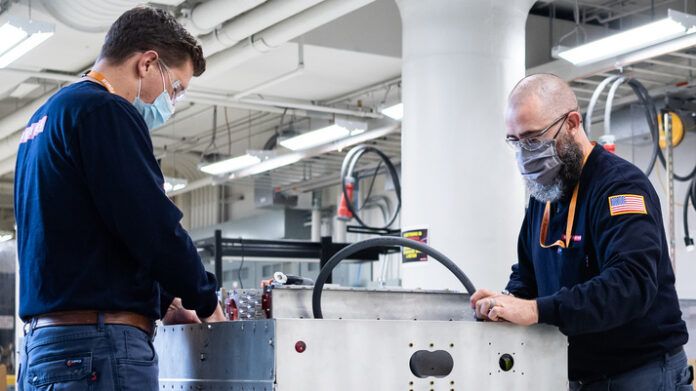GE Aviation has chosen BAE Systems to design, test and supply energy management components for its hybrid electric propulsion system demonstration program. For the project, BAE will be providing the battery and cabling used to store electricity and drive the motor/generator being built by GE Aviation. The program is part of a NASA and GE Aviation research partnership aimed at demonstrating the “flight readiness of an integrated hybrid electric propulsion system for single-aisle commercial aircraft.”
“We are excited about the opportunity to collaborate with BAE Systems on this demonstrator to advance energy storage systems at altitude,” said Mohamed Ali, GE Aviation vice president and general manager of engineering. “GE Aviation is leading the development of hybrid electric technology for commercial aviation through this NASA collaboration. Energy management is an important component of our research program toward a more electric future of aviation with reduced carbon emissions and less reliance on fossil-based jet fuels.”
GE says it will test hybrid electric configurations on a modified Saab 340B through NASA’s Electrified Powertrain Flight Demonstration (EPFD) project. BAE will also supply controls and cables for the power management system to be tested on the demonstrator aircraft’s CT7-9B turboprop engines. Ground and flight tests of are expected to take place in the mid-2020s.




































How much modification to the engine?
GM had a weak hybrid system years ago on its ground vehicles, something like replacing alternator and starter with a hefty unit that can back drive the engine, and extra battery of suitable type (deep cycle). https://en.wikipedia.org/wiki/Mild_hybrid
Will GE’s scheme be able to recover energy from descent? (Have to think that one through, propellers and flight energy – jet airliners dissipate it by flying near max speed in descent.)
It really can’t work.
Hybrid in cars works well. Very slow speeds compared to aircraft, and engines operating at a very low power setting with frequent changes and a lot of stop and go. None of this applies to aircraft.
As far as descent goes, fuel savings is automatic as a power reduction will drop the nose and plane will descend at trimmed airspeed. You can also leave it lean at the reduced power setting to reduce over-cooling and save more fuel that way.
A hybrid might help by boosting takeoff and climb power if a smaller ICE is used but the extra weight and complexity and expense would doubtless not be worth it.
Thanks.
The jets get thrust reduced to idle and descent at close to maximum airspeed, their cycle wants to be high as long as possible.
Airplane engine in question is a turboprop, i.e. turbine engine driving propeller.
Airplane in question has a service ceiling of 25,000 feet ASL. Turboprops don’t usually go as high as jets, including for reasons other than aerodynamics and engines, though the Herc can go much higher if empty or given more power.
“…the extra weight and complexity and expense would doubtless not be worth it”
Concur. I never understood the perceived advantage of the “battery boosted takeoff” hybrid idea. I suppose if your concept is an aircraft with sailplane-like aerodynamics that cruised at sailplane speeds while powered by a bare-minimum ICE that was insufficient for takeoff/climb, then maybe. But most folks will want a setup that can trade that climb power for speed at cruise.
Also HP/Gal/Hour is similar no matter the displacement of the engine. An O-360 operating at 120 HP will burn about 12 gal/hr. A O-540 operating at 120 HP will burn about the same per hour. The difference is the percent power of operation. Thus a smaller engine won’t save much but you lose flexibility and safety ,argin.
“with NASA collaboration” please read free government aka tax payer money. Mid 20s for ground tests, what about having an actual flying example. Oh wait more free money for the next step. What is not free money should be reviewed by some common sense shareholders.
“Mohammed Ali?” Is that his real name ?? Or is it a joke ?
Spelling is different, Larry.
“I’m so mean, I make medicine sick.”
Only one can be the greatest ever. 🙂
Sounds like a Muslim name, Ayan Hirsi Ali is a well known person, Mohammed is common as sand.
He was flawed of course but a brilliant fighter and a very interesting, albeit misled person.